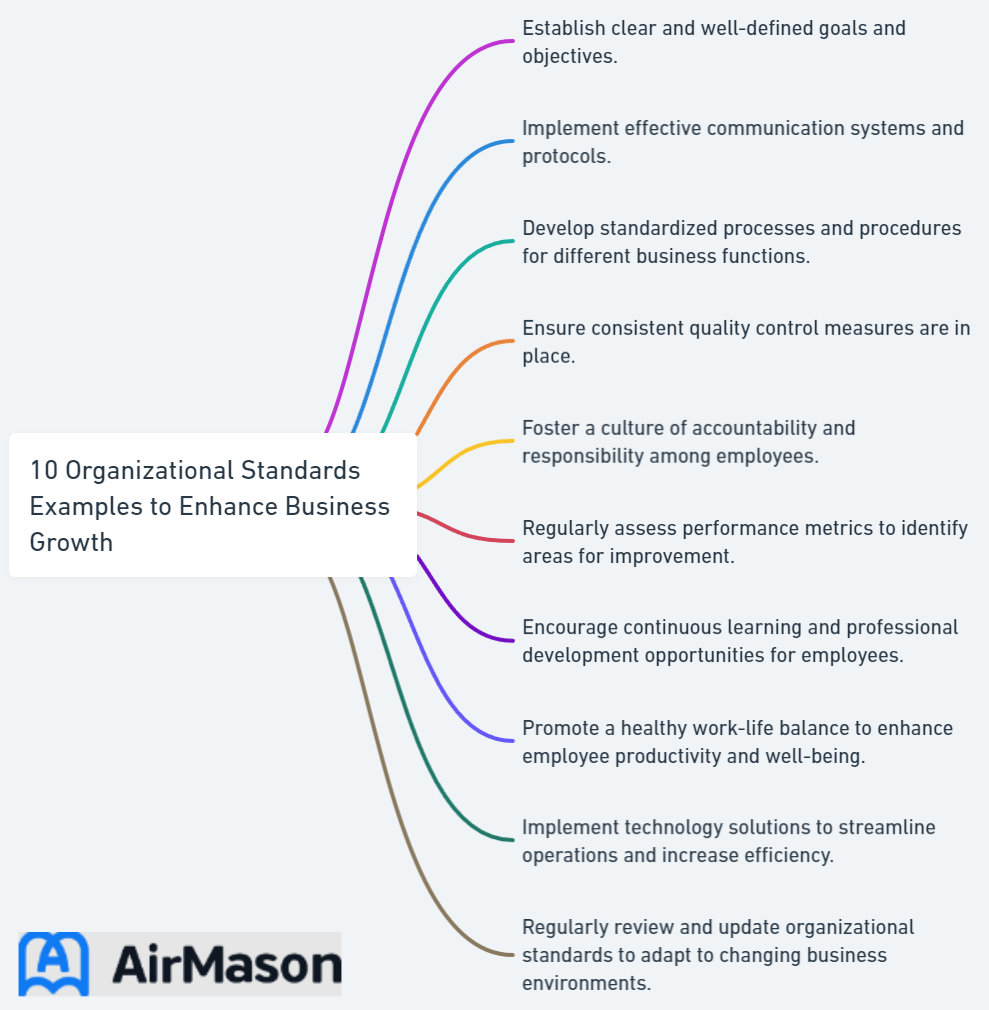
In today’s competitive business landscape, organizational standards play a crucial role in fostering growth and boosting employee satisfaction. These standards are instrumental in creating a thriving business environment, contributing to loyal customers, an improved employee experience, and successful business outcomes. But what exactly are these standards, often rooted in a company’s core values, and how can companies effectively implement them? In this journey, we’ll explore the definition, importance, and organizational standards examples, as well as provide case studies to showcase their successful implementation and positive impact on business growth and employee satisfaction.
Key Takeaways
- Organizational standards provide clarity, consistency, and potential savings that contribute to business growth.
- Examples of organizational standards include codes of ethics, health & safety policies, anti-discrimination guidelines, and data privacy protocols. These standards are essential in aligning with and supporting the achievement of business objectives, ensuring that every aspect of the company’s operations contributes towards meeting these priorities and challenges.
- Successful implementation involves defining objectives, consulting with employees, and monitoring effectiveness for maximum impact on employee satisfaction and business growth.
Employee Definition
The term “employee definition” refers to the explicit identification and characterization of individuals within an organization who are officially hired to perform specific tasks or roles. In the realm of human resources, the employee definition is crucial for establishing the boundaries of the workforce and determining the rights, responsibilities, and privileges associated with employment. This definition encapsulates the professional relationship between an employer and an individual engaged to contribute their skills and expertise to the organization. Understanding the employee definition is fundamental for legal and organizational purposes, as it shapes the contractual agreements, benefits, and expectations that govern the employer-employee relationship. In essence, the employee definition serves as the cornerstone for delineating the scope and parameters of the workforce within a given enterprise.
Organizational Standards: Definition and Importance
Organizational standards, a set of rules and guidelines, aim to foster consistency, elevate performance, and bolster reputations within businesses. Such standards are pivotal for growth and employee satisfaction, offering stability, ensuring uniformity, and elucidating employee roles and responsibilities. Incorporating corporate values into these standards is crucial, as they guide the company’s actions and decisions, reinforcing a commitment to principles that drive decision-making and employee behavior.
Effective implementation of these standards can lead to considerable time and resource savings by promoting consistency and efficiency throughout the organization, helping you save time.

Definition of Organizational Standards
Organizational standards refer to the protocols, processes, and directives that delineate a firm’s anticipations for employee conduct, proficiency, and determination-making. These standards apply to both private companies and public entities, and they include a wide range of policies and procedures that employees must follow to maintain an ethical and consistent work environment.
Some examples of organizational standards include:
- Code of ethics
- Health and safety policy
- Anti-discrimination and harassment guidelines
- Data privacy and security policy
- Employee training and development programs
- Performance management system
- Communication protocol
- Environmental sustainability policy
- Remote work policy
- Employee recognition and reward programs
Importance of Organizational Standards
The implementation of organizational standards plays a key role in fostering a positive work environment, maintaining legal compliance, and cultivating a robust company culture. A comprehensive set of standards can help businesses achieve these goals more effectively. For instance, a workplace rule set contributes significantly to the company’s stability, the assurance of consistency and uniformity, and the clarification of employee roles and responsibilities.
Moreover, a well-defined security protocol for online data can safeguard confidential information, such as mobile phones data, and ensure adherence to applicable laws and regulations.

The implementation of organizational standards plays a key role in fostering a positive work environment, maintaining legal compliance, and cultivating a robust company culture. A comprehensive set of standards can help businesses achieve these goals more effectively. For instance, a workplace rule set contributes significantly to the company’s stability, the assurance of consistency and uniformity, and the clarification of employee roles and responsibilities.
Moreover, a well-defined security protocol for online data can safeguard confidential information, such as mobile phones data, and ensure adherence to applicable laws and regulations.
Code of Ethics
A code of ethics is a document that outlines the company’s values and principles, providing guidance for employee behavior and decision-making based on the company’s rules. This document covers various topics, such as:
- Attendance and absence
- Employee behavior
- Company values
- Break and mealtime policies
- Confidentiality
- Use of company property
- Use of social media
- Plagiarism
- Travel policies
- Conflicts of interest
- Client interaction
- Dress code
- Reporting misconduct
A well-defined code of ethics can help ensure that employees make ethical decisions and adhere to the company’s rules, thus maintaining a harmonious and productive work environment.
Health and Safety Policy
A health and safety policy is a type of policy that outlines a company’s obligations under work health and safety laws and establishes how employees are safeguarded. These policies may encompass:
- Risk assessment
- Employee safety training
- First aid information
- Maintenance equipment
- Safe handling of materials and substances
- Supervision rules
- Delegation of authority
- Accident training
- Physical and mental health information
- Monitoring hazards
- Emergency procedures
The implementation of a health and safety policy promotes employee wellbeing by:
- Creating a safe and healthy workplace
- Offering sufficient training and supervision
- Promoting employee health
- Preventing workplace injuries and illnesses.
Anti-Discrimination and Harassment Guidelines
Anti-discrimination and harassment guidelines are designed to protect employee rights, ensuring that employees are free from any form of unfair treatment and fostering an inclusive workplace environment for all. These guidelines should be implemented at various stages of employment, such as:
- Recruitment
- Being presented with inequitable terms and conditions of employment
- Being denied any job opportunity
- Being unjustly demoted or dismissed
- Facing disciplinary action
Key components of an anti-discrimination and harassment policy encompass:
- Employee education and training, including drug and alcohol policy awareness
- Clear definitions of discrimination and harassment
- The establishment of guidelines for addressing these issues
- The implementation of procedures for employee grievances.
Data Privacy and Security Policy
A data privacy and security policy is of paramount importance for an organization as it assists in controlling the utilization, administration, and observation of data, safeguarding it from unauthorized access. Additionally, it helps maintain the organization’s reputation and assets by recognizing the risks associated with not protecting data. Implementing a data privacy and security policy can have a considerable effect on customers, impacting their perception of the brand, and on employees, influencing their view of the company culture. Moreover, adhering to data laws and regulations is essential to safeguard individuals’ privacy rights and avert data breaches.
Employee Training and Development Programs Aligned with Business Objectives
Employee training and development programs are a series of educational activities devised to augment employees’ knowledge and capabilities. These programs strive to improve job performance, bridge performance disparities, and augment productivity. Examples of employee training and development programs include on-the-job training, online courses, workshops, and mentoring programs.
Employee training and development programs are of great importance in an organization as they can:
- Increase job satisfaction
- Boost productivity
- Enhance employee retention
- Aid companies in gaining and retaining top talent
- Raise job satisfaction and morale
- Augment productivity
- Enable employees to remain up-to-date and acquire fresh competencies.
Performance Management System
A performance management system in organizational standards is a systematic process that involves establishing objectives, tracking progress, and assessing the performance of personnel in order to maximize their contributions to the organization and its objectives. This system may encompass activities such as performance appraisal, employee development, and recognition and reward.
Performance management systems help:
- Align employees with company goals
- Empower teams
- Foster a culture of accountability and continuous improvement
- Enhance overall performance and outcomes
Communication Protocol for a Positive Company Culture
A communication protocol in an organization is a formal process that delineates the kinds of information to be disseminated within the organization and specifies the individual(s) accountable for communication. It assists in establishing expectations and accentuates open and frequent communication among staff members. Communication protocols can be conveyed through a variety of channels, such as meetings, emails, and training sessions.
By enhancing communication, accountability, team health, and outcomes, a communication protocol facilitates collaboration within the organization and guarantees everyone is cognizant of the same information.
Environmental Sustainability Policy
Environmental sustainability policies demonstrate a company’s commitment to reducing its environmental impact and promoting sustainable practices. The essential elements of a successful environmental sustainability policy include:
- Comprehending and evaluating the company’s environmental impact
- Establishing definite and quantifiable objectives for sustainability
- Unifying leaders and personnel on the purpose and rationale of the policy
- Instituting sustainable procedures and practices
- Guaranteeing transparency and responsibility in reporting progress
- Involving stakeholders and encouraging collaboration
- Constantly assessing and optimizing the policy based on feedback and new data
Implementing environmental sustainability policies can help businesses decrease costs, augment efficiency, minimize waste and pollution, preserve resources, and enhance their reputation.
Remote Work Policy
A remote work policy is a set of principles and rules that outline the expectations of both the employer and employees when work is being done remotely. It is essential for the smooth running of business operations when employees are not based in the office, providing clarity on eligibility, availability, and other pertinent aspects of remote work. Implementing effective workplace policies, including remote work policies, ensures a well-organized and productive work environment.
Furthermore, a well-defined remote work policy can lead to enhanced productivity and work-life balance for employees. An effective remote work policy should include:
- Clear eligibility requirements
- Scheduling and availability guidelines
- Providing necessary tools and equipment
- Setting expectations for remote work performance and productivity
- Offering remote work benefits and compensation
- Outlining guidelines for the physical work environment
- Implementing security and privacy measures
Employee Recognition and Reward Programs

Employee recognition and reward programs serve to motivate and engage employees, thus leading to enhanced job satisfaction and retention. Various employee recognition and reward programs are available, such as:
- Monetary rewards
- Non-monetary rewards
- Recognition awards
- Recognition events
The advantages of employee recognition and reward programs encompass enhanced employee engagement, enhanced job satisfaction, and augmented retention. Some successful examples of implementing employee recognition and reward programs include Google’s “Peer Bonus” program, Microsoft’s “Employee of the Month” program, and Apple’s “Employee of the Year” program.
Implementing Organizational Standards
The process of implementing organizational standards includes the following steps:
- Defining the standards
- Devising an action plan
- Disseminating the standards to stakeholders
- Assessing their effectiveness
Following this process can help businesses guarantee the effective implementation and adherence to their organizational standards.
In the following sections, we will discuss the process of developing, communicating, and monitoring organizational standards in more detail.
Developing Organizational Standards

Developing organizational standards requires evaluating the company’s needs, consulting with employees, and formulating clear, specific guidelines. This can be achieved through a needs assessment, which involves examining the discrepancies between current practices, knowledge, or skills within the organization and the desired standards.
Involving employees in the development process offers several benefits, including:
- Fostering a sense of value and involvement among employees
- Promoting transparency and respect
- Ensuring effective changes
- Boosting employee engagement
- Facilitating the management of human resources according to the most recent trends and requirements.
Communicating Organizational Standards
Relaying organizational standards to employees is vital for securing their compliance and maximizing effectiveness. This can be achieved through various channels, such as meetings, emails, and training sessions. Regularly scheduling discussions and meetings to present a particular policy and ensuring employees have convenient access to the standards and guidelines can help increase understanding and compliance.
Monitoring and Evaluating Organizational Standards

The process of monitoring and evaluating organizational standards entails periodic reviews of their effectiveness, collecting employee feedback, and making requisite adjustments. This can be achieved through various methods, such as statistical analysis, benchmarking, and surveys. Tools such as Ziflow, Camms.Risk, Sprinto, PowerDMS, and Qualtrax can be utilized for monitoring adherence to organizational norms.
Continual monitoring and evaluation of organizational standards enable businesses to maintain their effectiveness and implement necessary improvements.
Case Studies: Successful Implementation of Organizational Standards
Companies such as Dell Computer, Google, and General Electric have successfully implemented organizational standards, showcasing their positive impact on business growth and employee satisfaction. For example, Google, as a global company, has demonstrated that organizational standards are crucial in sustaining essential fundamentals during its remarkable growth and guaranteeing workforce expertise through a robust company culture.
Amazon’s implementation of organizational standards focused on fostering diversity, relaxing performance standards, and enhancing employee engagement, resulting in a more inclusive and supportive work environment and increased employee satisfaction.
Summary
In conclusion, organizational standards play a crucial role in fostering business growth and boosting employee satisfaction. By implementing well-defined standards, businesses can ensure consistency, efficiency, and compliance with laws and regulations. Moreover, they contribute to creating a positive work environment and a strong company culture, ultimately leading to increased job satisfaction and employee retention. Establishing a robust code of conduct and a systematic process for collecting, reviewing, and implementing feedback can foster a positive company culture, further enhancing job satisfaction and employee retention. With the right approach to developing, communicating, and monitoring organizational standards, businesses can unlock their full potential and achieve sustainable growth.
Employee Pledge of Commitment Sample
In crafting an employee pledge of commitment sample, it is crucial to articulate clear expectations and values that align with the organization’s mission. An effective employee pledge of commitment sample should outline not only the responsibilities and duties expected from the employee but also emphasize the importance of dedication, integrity, and collaboration within the workplace. This document serves as a foundation for fostering a positive and committed work environment, encouraging employees to actively contribute to the organization’s success while adhering to its core principles.
Frequently Asked Questions
What are Organisational standards?
Organisational standards are the principles and procedures which ensure a conducive learning and research environment in an institution. These standards provide a framework for ensuring quality and consistency of processes.
What is an example of a standard in a company?
Companies often follow standardization protocols to ensure quality and consistency across their products. For instance, GAAP are utilized for financial reporting, while product standards specify details such as thread count and dye amount in specific products.
What is the purpose of organizational standards?
Organizational standards are essential to ensure quality, interoperability of products and the technological baseline necessary for future development. They also help ensure agencies have the necessary organizational capacity to accomplish their mission.
What is standard in organization and management?
Standardization within an organization is an agreed way of carrying out tasks and activities, ensuring the same level of quality in products and services. It helps to ensure consistency, productivity and efficiency in the workplace.
How can businesses develop effective organizational standards?
Businesses can effectively develop organizational standards by assessing their needs, consulting with employees and creating clear guidelines. This allows organizations to create consistent expectations for all employees.